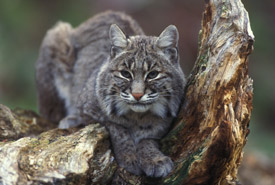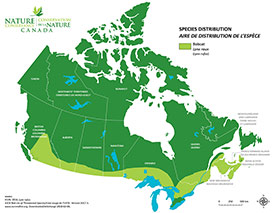
Bobcat (Photo by Gary Kramer, courtesy of USFWS)
Bobcat
As both predator and prey, life is a fine balance for the bobcats of Quebec's Sutton Mountains. Moving stealthily through the forest, the bobcat searches for mice and rabbits, and attempts to avoid coyotes and other predators.
Bobcat or lynx?
About three times the size of an average housecat, the bobcat is often mistaken for a lynx, and requires careful examination to distinguish it from its northern relative. The bobcat is smaller in size, its legs are shorter and its black-striped and white-tipped tail is longer than that of the lynx.
Where does the bobcat live?
Generally nocturnal, the bobcat is a solitary stalker and requires large continuous expanses of habitat for its survival. It will mark its territory with claw marks, feces and urine. Bobcats reside throughout North America, ranging from southern Canada, to the continental United States and northern Mexico. This feisty feline can adapt to many different habitats, including forests, swamplands, deserts and even urban outreaches.
When does the bobcat breed?
Bobcats breed from winter to spring and have a gestation period of approximately two months. While a mother is still nursing, she will bring live mice to her kittens so they can practice hunting.
What is the conservation status of this species?
Bobcats are an indicator species — the health of their population is indicative of habitat connectivity. Although the bobcat has managed to survive after centuries of extensive hunting and trapping, it is currently threatened by human development and urban sprawl.
What is NCC doing to protect habitat for this species?
NCC has currently secured 18 properties in the Chignecto Isthmus Natural Area, which total more than 1,390 hectares (3,435 acres). These properties are located near Sackville, New Brunswick, and Amherst, Nova Scotia.
NCC’s Mount Burnt property, which is a vast forest landscape stretching between Quebec and Vermont, along with the plains of the Missouri Coteau in Saskatchewan, are excellent examples of wildlife corridors that NCC is working to protect. Bobcats are also found in northern New Brunswick, at NCC’s nature reserve in Bartholomew River, and in south and central Nova Scotia at NCC’s reserves in Silver River and Cobequid Hills. At New Brunswick’s Musquash Estuary, in the Chignecto Isthmus, and in Cape Breton, Nova Scotia, NCC has ongoing projects to expand and protect more habitat for bobcat and other species.
Working with our partners and supporters, NCC is identifying, conserving and connecting the large-scale habitats needed to keep bobcats and other wildlife healthy, with lots of room to roam.






